There are many ways to obtain it, through SKCameraNode, using UIKit elements like UIScrollView or other ways..
But I want to show you how to do it simple with SpriteKit only.
Conceptually, you should build a larger SKNode that containt every single voice of your menu where each element have an equal distance from the other.
You can simulate the scrolling with an SKAction that move our node to the center of the nearest visible element.
GameViewController:
class GameViewController: UIViewController {
override func viewDidLoad() {
super.viewDidLoad()
guard let view = self.view as! SKView? else { return }
view.ignoresSiblingOrder = true
view.showsFPS = true
view.showsNodeCount = true
view.showsPhysics = false
view.showsDrawCount = true
let scene = GameScene(size:view.bounds.size)
scene.scaleMode = .aspectFill
view.presentScene(scene)
}
}
GameScene:
class GameScene: SKScene {
var lastX: CGFloat = 0.0
var moveableArea = SKNode() // the larger SKNode
var worlds: [String]! = ["world1","world2","world3"] // the menu voices
var currentWorld:Int = 0 // contain the current visible menu voice index
var worldsPos = [CGPoint]() // an array of CGPoints to store the menu voices positions
override func didMove(to view: SKView) {
//Make a generic title
let topLabel = SKLabelNode.init(text: "select world")
topLabel.fontSize = 40.0
self.addChild(topLabel)
topLabel.zPosition = 1
topLabel.position = CGPoint(x:frame.width / 2, y:frame.height*0.80)
// Prepare movable area
self.addChild(moveableArea)
moveableArea.position = CGPoint(x:self.frame.midX,y:self.frame.midY)
// Prepare worlds:
for i in 0..<worlds.count {
// add a title for i^ world
let worldLabel = SKLabelNode.init(text: worlds[i])
self.moveableArea.addChild(worldLabel)
worldLabel.position = CGPoint(x:CGFloat(i)*self.frame.width ,y:moveableArea.frame.height*0.60)
// add a sprite for i^ world
let randomRed = CGFloat(drand48())
let randomGreen = CGFloat(drand48())
let randomBlue = CGFloat(drand48())
let randomColor = UIColor(red: randomRed, green: randomGreen, blue: randomBlue, alpha: 1.0)
let worldSprite = SKSpriteNode.init(color: randomColor, size: CGSize.init(width: 100.0, height: 100.0))
worldSprite.name = worlds[i]
self.moveableArea.addChild(worldSprite)
worldSprite.position = CGPoint(x:CGFloat(i)*self.frame.width ,y:0.0)
}
}
func tapNode(node:SKNode,action:SKAction) {
if node.action(forKey: "tap") == nil {
node.run(action, withKey: "tap")
}
}
override func touchesBegan(_ touches: Set<UITouch>, with event: UIEvent?) {
let touch = touches.first!
let location = touch.location(in: self)
let touchedNode = self.atPoint(location)
lastX = location.x
let sequence = SKAction.sequence([SKAction.scale(to: 1.5, duration: 0.2),SKAction.scale(to: 1.0, duration: 0.1)]) // a little action to show the selection of the world
switch touchedNode.name {
case "world1"?:
print("world1 was touched..")
tapNode(node:touchedNode,action:sequence)
case "world2"?:
print("world2 was touched..")
tapNode(node:touchedNode,action:sequence)
case "world3"?:
print("world3 was touched..")
tapNode(node:touchedNode,action:sequence)
default:break
}
}
override func touchesMoved(_ touches: Set<UITouch>, with event: UIEvent?) {
let touch = touches.first!
let location = touch.location(in: self)
let currentX = location.x
let leftLimit:CGFloat = CGFloat(worlds.count-1)
let rightLimit:CGFloat = 1.0
let scrollSpeed:CGFloat = 1.0
let newX = moveableArea.position.x + ((currentX - lastX)*scrollSpeed)
if newX < self.size.width*(-leftLimit) {
moveableArea.position = CGPoint(x:self.size.width*(-leftLimit), y:moveableArea.position.y)
}
else if newX > self.size.width*rightLimit {
moveableArea.position = CGPoint(x:self.size.width*rightLimit, y:moveableArea.position.y)
}
else {
moveableArea.position = CGPoint(x:newX, y:moveableArea.position.y)
}
// detect current visible world
worldsPos = [CGPoint]()
for i in 0..<worlds.count {
let leftLimit = self.size.width-(self.size.width*CGFloat(i))
let rightLimit = self.size.width-(self.size.width*CGFloat(i+1))
if rightLimit ... leftLimit ~= moveableArea.position.x {
currentWorld = i
}
worldsPos.append(CGPoint(x: (rightLimit + (leftLimit - rightLimit)/2), y:moveableArea.position.y))
}
lastX = currentX
}
override func touchesEnded(_ touches: Set<UITouch>, with event: UIEvent?) {
if worldsPos.count>0, moveableArea.action(forKey: "moveAction") == nil {
let moveAction = SKAction.move(to: worldsPos[currentWorld], duration: 0.5)
moveAction.timingMode = .easeInEaseOut
self.moveableArea.run(moveAction, withKey: "moveAction")
}
}
}
As you can see , with touchesBegan we can detect the touched world and select it, with touchesMoved we are able to move the moveable node to the correct position and to detect the nearest visible world and with touchesEnded we can create the smooth scrolling to automatic move to the current nearest visible voice after a touch..
Output:

